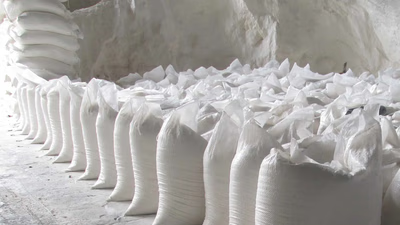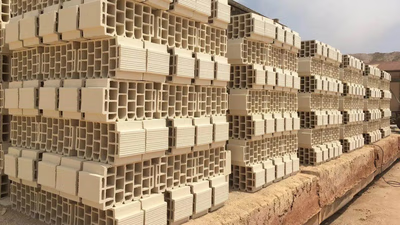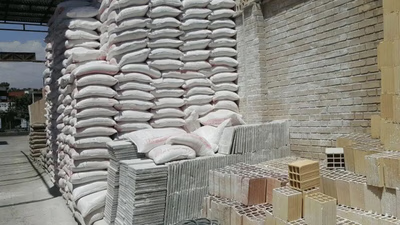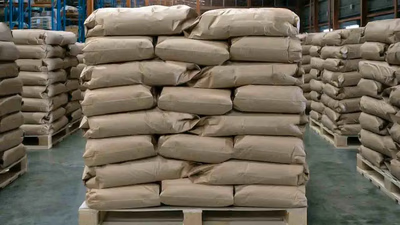
Clay bricks and tiles: essential materials for construction.
Clay is a primary ingredient in the production of bricks and blocks. It is mixed with water, shaped, and then dried or fired to create durable and strong building materials. Clay bricks are widely used for load-bearing walls, partitions, and facades due to their thermal insulation properties and aesthetic appeal. Clay is used in traditional earthen construction techniques such as adobe, rammed earth, and cob. These methods involve mixing clay with other materials like sand, straw, or organic fibers to create walls that are strong, sustainable, and provide excellent thermal mass.
Clay can be used as a plastering material for interior and exterior surfaces. Clay plaster offers natural beauty, breathability, and good thermal insulation. It can be applied to various substrates, including masonry, straw bales, or timber, providing a smooth and natural finish. Clay is used to manufacture roofing tiles that are durable, weather-resistant, and aesthetically pleasing. Clay tiles are popular in regions with hot climates as they provide good insulation, reflectivity, and can withstand extreme temperatures.
Soil is a combination of excellent minerals and minerals created by weathering and rock destruction. Soils are divided into two categories, sticky and non-sticky, and have fine or coarse granulation. The most superficial layer is the soil surface, the type of which depends on climatic conditions, the type of primary rock, the activity of living organisms and the geographical area. Clay is one of the types of sticky soils that is used in construction. This soil is the result of erosion of metamorphic and igneous rocks and because of its very fine grains, it is also called colloid. The important point in using this material is to choose a quality sample of it. Clay is the best material that can be used to control the temperature of the building.
The use of clay helps to create heat stability in the building. Since houses are built in such a way that hot or cold weather penetrates inside in summer and winter, the use of clay in construction can be very effective in stabilizing heat and cold and controlling temperature. Clay is used in the production of construction materials such as bricks, tiles, ceramics, gypsum and soil mortars, lime mortar, mud straw and pottery. The main reason for using this material is its reasonable price, ease of use and slowness.
In drainage and sewer systems, clay pipes have been commonly used due to their durability and resistance to corrosion. Clay pipes are known for their longevity and ability to withstand high-pressure conditions. Clay is used for landscaping purposes, such as creating decorative elements, terracotta pots, and ornamental features. Its malleability allows for intricate designs and customization, enhancing the visual appeal of outdoor spaces. Clay is employed as a natural liner in landfills, ponds, and reservoirs due to its low permeability. It acts as a barrier to prevent the leakage of water or contaminants.
Clay-based materials, such as expanded clay aggregates or lightweight clay blocks, are used for thermal insulation in walls, roofs, and floors. These materials have good thermal properties, helping to maintain comfortable indoor temperatures and reduce energy consumption. In geotechnical engineering, clay is used to stabilize soil and prevent erosion. Clay can be mixed with other materials to create barriers, embankments, or retain walls in construction projects. Clay-based paints and coatings are gaining popularity as eco-friendly alternatives to conventional paints. These natural finishes provide a breathable surface, regulate moisture, and contribute to healthier indoor air quality.
-

Gypsum plaster is a versatile building material widely used for interior finishes, providing a smooth and durable surface for walls and ceilings. It is a key component of drywall systems, offering benefits such as fire resistance and sound insulation. Gypsum plaster is also essential in repair and restoration work, allowing for the patching and leveling of damaged surfaces. Various types of gypsum plaster, including whitewash, micronized, ivory, Gipton, and Siwa plaster, cater to different construction needs, from decorative elements to moisture resistance. Gypsum plaster can be molded into intricate shapes for architectural detailing and is commonly applied in plaster skimming to achieve a uniform finish. Additionally, it is utilized in the construction of false ceilings, concealing services while enhancing aesthetics. Gypsum plaster"s acoustic properties make it suitable for sound treatment in spaces like theaters and studios. Its inherent fire resistance contributes to building safety, enabling the creation of fire-rated structures. The adaptability of gypsum plaster, combined with its various formulations, makes it a crucial material in the Middle East"s construction industry, supporting both residential and commercial projects.
-

Construction sand is essential for concrete and mortar, forming a key part of the aggregate mix used in various construction projects. The rapid growth of the construction sector in West Asia has led to increased demand for sand, necessary for residential, commercial, and infrastructure developments. Countries like the UAE, Qatar, and Saudi Arabia have implemented strict quality standards for construction materials, including sand, to ensure durability and strength. However, local availability varies; some nations depend on imports due to limited natural sources. For instance, Dubai imports sand from Australia for land reclamation projects. Coastal countries like Bahrain and Qatar can source sand locally, but this raises environmental concerns such as coastal erosion. The extraction of sand from riverbeds and coastal areas can disrupt ecosystems and lead to stricter regulations. To address environmental impacts, alternative materials like recycled concrete aggregates and manufactured sand are being explored.
The prices of construction sand fluctuate based on availability, demand, and regulations, affecting overall construction costs. Sustainable sand management practices are being adopted in some West Asian countries to promote responsible sourcing and alternative materials, ensuring the construction industry can meet its needs without compromising the environment.
-

Concrete, steel, bricks, wood, and aggregates are essential materials in civil construction, each offering unique properties. Concrete, a mixture of cement, aggregates, and water, is favored for its strength and versatility. Steel is crucial for structural integrity, providing high strength and corrosion resistance. Bricks, made from clay or concrete, contribute to thermal insulation and aesthetics. Wood is valued for its renewability and insulation properties, while aggregates serve as fillers in various construction applications. Asphalt is used for paving, ensuring durability and smooth surfaces. Cement acts as a binding agent in concrete and mortar, while glass enhances natural light and aesthetics in buildings. Understanding these materials is vital for construction professionals to create durable structures.
The industry also sees innovations with new materials like bitumen membranes and plastic composites, which improve moisture resistance and insulation. Familiarity with both traditional and modern materials is essential for effective construction planning and execution.
-

The Middle East"s construction sector is thriving, fueled by urbanization, population growth, and ambitious development plans. Major cities like Dubai, Abu Dhabi, and Doha are undergoing extensive construction, including skyscrapers and infrastructure projects, driven by government investments aimed at economic diversification. The region"s hosting of mega-events, such as the Dubai Expo 2020 and FIFA World Cup 2022, has further increased demand for building materials. A notable trend is the shift towards sustainable construction practices, with a rising interest in eco-friendly materials and energy-efficient designs. The Middle East is a significant player in the global cement market, exporting millions of tons of clinker, with Iraq being the largest buyer. The building materials market in West Asia includes both locally produced and imported materials, with local production focusing on cement, steel, and ceramics. The competitive landscape features both local companies and international suppliers, catering to diverse material preferences influenced by regional regulations and economic conditions. Advanced construction technologies, such as 3D printing and modular construction, are being adopted to enhance efficiency. Investments in infrastructure development are also substantial, requiring a wide array of building materials, thus presenting lucrative opportunities for suppliers and manufacturers.
-

Cement is a crucial material in construction, with various types serving specific purposes. Ordinary Portland Cement (OPC) is the most widely used, suitable for general construction. Blended cements, like Pozzolanic Portland Cement (PPC), enhance durability and are ideal for aggressive environments. Rapid Hardening Cement is designed for projects requiring quick strength gain, while Sulphate Resistant Cement protects structures from sulfate attacks. High Alumina Cement offers heat resistance for high-temperature applications. Other types include Colored Cement for aesthetic finishes, Refractory Cement for extreme conditions, and Waterproofing Cement for moisture protection. Each type of cement is formulated to meet specific construction needs, ensuring structural integrity and longevity. The choice of cement impacts the overall performance of construction projects, making it essential for builders to understand the properties and applications of each type.
-

Clay is essential in construction, primarily for producing bricks and blocks. It is mixed with water, shaped, and fired to create durable materials. Clay bricks are favored for their thermal insulation and aesthetic appeal, making them ideal for load-bearing walls and facades. Traditional construction techniques like adobe and rammed earth utilize clay mixed with sand and organic fibers, resulting in sustainable structures with excellent thermal mass. Clay also serves as a plastering material, offering breathability and insulation for various surfaces. Additionally, clay roofing tiles are popular for their durability and weather resistance, particularly in hot climates. The soil"s composition, including clay"s fine grains, affects its construction properties. Clay"s ability to stabilize temperature in buildings enhances energy efficiency.
It is also used in drainage systems due to its corrosion resistance. Beyond construction, clay is utilized in landscaping and as a natural liner for landfills. Its thermal insulation properties are harnessed in lightweight clay blocks and aggregates. In geotechnical engineering, clay stabilizes soil and prevents erosion. Eco-friendly clay-based paints are emerging as alternatives to conventional options, promoting healthier indoor air quality. The versatility of clay in construction and landscaping highlights its importance in the Middle East"s trade landscape, particularly within B2B marketplaces focused on regional product listings and verified exporters.






